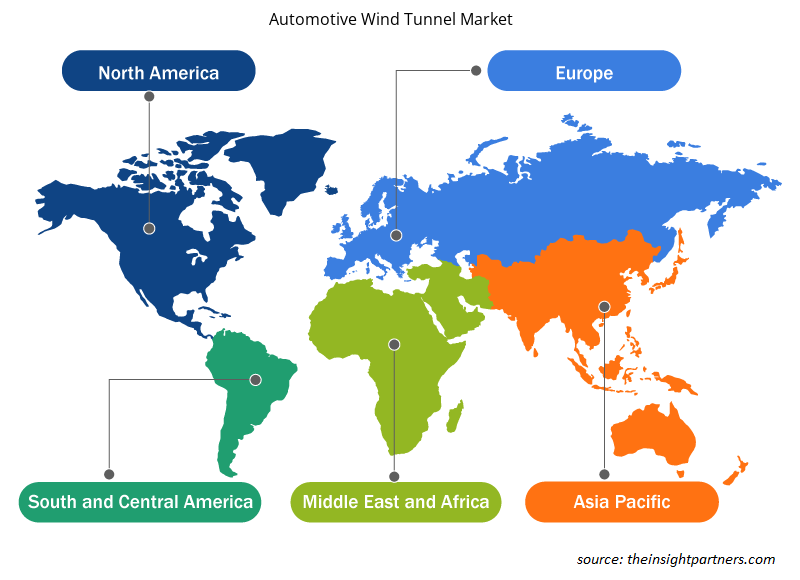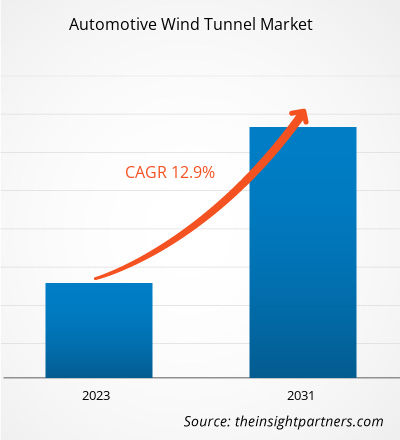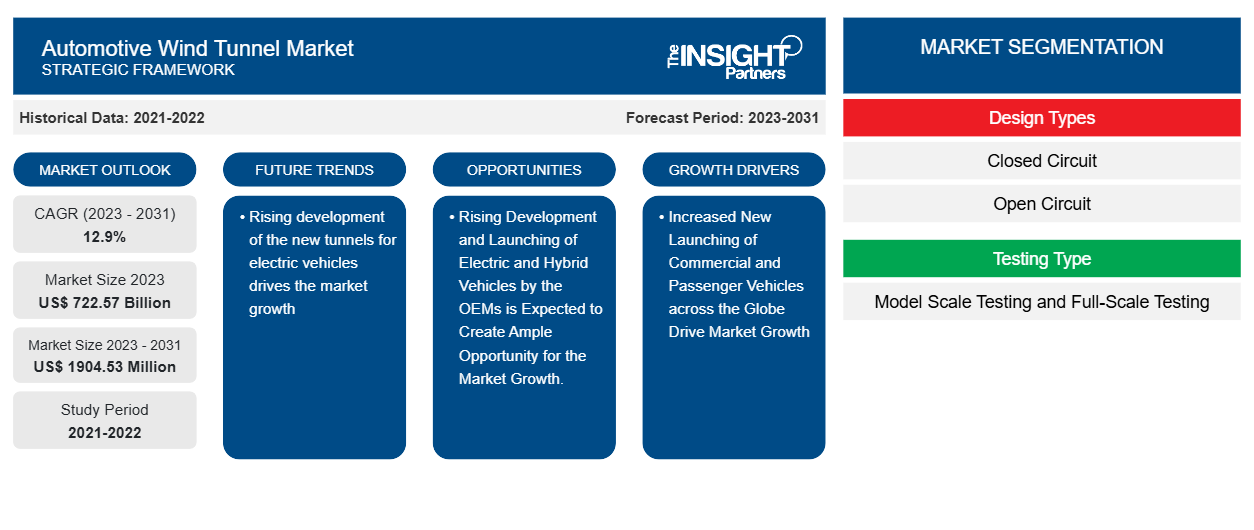Se proyecta que el tamaño del mercado de túneles de viento para automóviles alcance los 1904,53 millones de dólares en 2031, frente a los 722,57 mil millones de dólares en 2023. Se espera que el mercado registre una CAGR del 12,9% en 2022-2031. Un túnel de viento para automóviles es un entorno controlado diseñado para simular las condiciones naturales del viento para evaluar el rendimiento aerodinámico de los vehículos. El aumento de las ventas y la producción de automóviles en todo el mundo está impulsando el crecimiento del mercado durante el período de pronóstico. Según la Organización Internacional de Fabricantes de Vehículos de Motor, las ventas de vehículos comerciales en todo el mundo alcanzaron los 27,45 millones de unidades en 2023, lo que supone un aumento del 11,7% en comparación con 2022. Las pruebas de vehículos comerciales utilizan túneles de viento para automóviles con el fin de probar la aerodinámica de los vehículos.
Análisis del mercado de túneles de viento para la industria automotriz
El mercado de túneles de viento para automóviles está impulsado por el aumento de la producción automotriz con el aumento de las ventas de vehículos nuevos en todo el mundo. Según la Organización Internacional de Fabricantes de Vehículos Automotores, las ventas de automóviles alcanzaron los 92,72 millones de unidades en 2023, un aumento del 10,6% en comparación con 2022. Este crecimiento en las ventas de automóviles se debe principalmente al aumento de los ingresos disponibles de las personas, lo que ha creado una demanda masiva del mercado de túneles de viento para automóviles durante el período de pronóstico.
Además, el creciente lanzamiento de nuevos vehículos por parte de los principales fabricantes de equipos originales de todo el mundo ha creado una demanda masiva para el crecimiento del mercado de túneles de viento automotrices durante el período de pronóstico.
Descripción general del mercado de túneles de viento para la industria automotriz
Un túnel de viento para automóviles Un túnel de viento normalmente consta de una sección de prueba donde se puede montar un modelo o vehículo y observarlo mientras se sopla aire o, más habitualmente, se lo succiona con un ventilador o varios ventiladores. Algunos de los elementos clave que nos diferencian de casi todos los demás túneles de viento del mundo son el uso de nuestra carretera rodante y el sistema de movimiento del modelo integrado (cabeceo, balanceo, guiñada, elevación y dirección de las ruedas delanteras automatizados), que permite realizar pruebas más realistas. En un esfuerzo continuo por encontrar la herramienta de prueba perfecta, ARC se compromete a desarrollar su tecnología de túnel de viento para que vaya en paralelo a las mejoras en la tecnología. Un túnel puede probar modelos a escala de hasta el 50% que replican vehículos de carreras, de producción, comerciales y militares a escala real con un nivel de detalle muy alto. Un túnel de viento es uno de los componentes clave que ayuda a diferenciar al túnel de viento de casi todos los túneles de viento disponibles comercialmente en el mundo. Al comienzo de la sección de la carretera hay una caja de succión para garantizar un flujo correcto de la capa límite a lo largo de toda la carretera.
Personalice este informe según sus necesidades
Obtendrá personalización en cualquier informe, sin cargo, incluidas partes de este informe o análisis a nivel de país, paquete de datos de Excel, así como también grandes ofertas y descuentos para empresas emergentes y universidades.
- Obtenga las principales tendencias clave del mercado de este informe.Esta muestra GRATUITA incluirá análisis de datos, desde tendencias del mercado hasta estimaciones y pronósticos.
Factores impulsores y oportunidades del mercado de túneles de viento para la industria automotriz
El aumento de nuevos lanzamientos de vehículos comerciales y de pasajeros en todo el mundo impulsa el crecimiento del mercado
El aumento del lanzamiento de nuevos vehículos por parte de los fabricantes de equipos originales en todo el mundo es el principal factor impulsor del crecimiento del mercado de túneles de viento para automóviles durante el período de pronóstico. Por ejemplo, en diciembre de 2023, BMW Group planeó lanzar mini-SUV en India para 2024. La nueva serie incluye variantes eléctricas y de combustión interna. Los nuevos lanzamientos de BMW incluyen el X1 y el BMW Serie 7, y los modelos SUV X5 y X7 actualizados. El lanzamiento de este nuevo vehículo requiere varias pruebas antes de su lanzamiento al mercado. Las pruebas del vehículo requieren un túnel de viento automotriz para proporcionar las calificaciones de seguridad de los vehículos.OEMs across the globe is the major driving factor for the automotive wind tunnel market growth during the forecast period. For instance, in December 2023, BMW Group planned to launch mini-SUVs in India for 2024. The new series includes both electric and ICE variants. BMW's new launches include the X1 and the BMW 7 Series, and the updated X5 and X7 SUV models. Such new vehicle launching requires several tests before launching into the market. The vehicle testing requires automotive wind tunnel to provide the safety ratings of the vehicles.
Los túneles de viento para automóviles se utilizan ampliamente para realizar pruebas aerodinámicas de los vehículos. Varios fabricantes de vehículos utilizan túneles de viento para reproducir pruebas de vehículos del mundo real para sus modelos de vehículos y pruebas de vehículos de carga. Las pruebas en túneles de viento para automóviles proporcionan una forma validada de simular datos de modelos de automóviles y permiten al ingeniero medir el efecto acústico de los tratamientos de reducción de ruido en los vehículos.
Los vehículos de pasajeros y los vehículos comerciales de alta velocidad dependen especialmente del ruido aerodinámico. Las mediciones del ruido aerodinámico en el interior de los automóviles se llevan a cabo en vehículos de tamaño completo en túneles de viento en varias fases de desarrollo, ya que el ruido aerodinámico es la principal fuente de ruido en los automóviles a velocidades de crucero y superiores.
Se espera que el creciente desarrollo y lanzamiento de vehículos eléctricos e híbridos por parte de los fabricantes de equipos originales (OEM) cree amplias oportunidades para el crecimiento del mercado.
La aparición de vehículos eléctricos en todo el mundo, junto con el aumento de las ventas de estos vehículos, ha creado una demanda masiva del mercado de túneles de viento para automóviles por parte de los fabricantes de equipos originales. Los fabricantes de automóviles están utilizando este tipo de túnel de viento para probar la aerodinámica de los vehículos. Los fabricantes de vehículos eléctricos deben cumplir con ciertas pruebas para analizar el rendimiento de seguridad de los vehículos. Se espera que el creciente lanzamiento de estos vehículos eléctricos e híbridos por parte de los principales fabricantes de equipos originales de todo el mundo cree una amplia oportunidad para el crecimiento del mercado de túneles de viento para automóviles durante el período de pronóstico. Por ejemplo, en 2023, Tata Motors Ltd. lanzó el vehículo eléctrico Tata Punch como un automóvil de pasajeros para los consumidores indios. La empresa lanzó estos vehículos para cumplir con las regulaciones gubernamentales respetuosas con el medio ambiente y frenar las emisiones de carbono. Esta prueba de vehículos requiere túneles de viento para automóviles para probar la aerodinámica de los vehículos.OEMs. The automotive manufacturers are utilizing this type of wind tunnel in order to test the aerodynamics of the vehicles. fulfil certain tests for analyzing the safety performance of the vehicles. The increasing launching of these electric and hybrid vehicles by the leading OEMs across the globe is expected to create ample opportunity for the automotive wind tunnel market growth during the forecast period. For instance, in 2023, Tata Motors Ltd. launched the Tata Punch electric vehicle as a passenger car for Indian consumers. The company launched these vehicles in order to meet the environment-friendly government regulations and curb carbon emissions. This vehicle testing requires automotive wind tunnels for testing the aerodynamics of the vehicles.
Informe de mercado de túneles de viento para automóviles Análisis de segmentación
Los segmentos clave que contribuyeron a la derivación del análisis del mercado del túnel de viento automotriz son el tipo, la plataforma, la aplicación y el usuario final.
- Según los tipos de diseño, el mercado se divide en circuitos cerrados y circuitos abiertos.
- Según el tipo de prueba, el mercado global de túneles de viento automotrices se divide en pruebas a escala modelo y pruebas a escala real.
- Según la aplicación, el mercado se divide en turismos, vehículos comerciales y motocicletas.
Análisis de la cuota de mercado de los túneles de viento para la industria automotriz por geografía
El alcance geográfico del informe de mercado del túnel de viento automotriz se divide principalmente en cinco regiones: América del Norte, Europa, Asia Pacífico, Medio Oriente y África, y América del Sur.
Se espera que Asia Pacífico tenga la mayor participación en 2023. Esto se debe principalmente a la creciente demanda de los fabricantes de equipos originales de automóviles para probar la aerodinámica de los vehículos. Varios fabricantes de equipos originales de esta región están lanzando nuevos vehículos para satisfacer la creciente demanda de los consumidores de vehículos nuevos y basados en tecnología avanzada.
El mercado de túneles de viento para automóviles en América del Norte está creciendo a un ritmo rápido en 2023. Esto se debe principalmente al aumento de la producción y el lanzamiento de vehículos comerciales por parte de los fabricantes de equipos originales en esta región. Según la Organización Internacional de Fabricantes de Vehículos de Motor (OICA), las ventas de vehículos comerciales alcanzaron los 10,4 millones de unidades en 2022 y aumentaron en 9,7 millones en comparación con el año anterior, 2021. Además, la demanda del mercado de túneles de viento para automóviles está impulsada por el creciente lanzamiento de nuevos vehículos por parte de los principales fabricantes de marcas automotrices de América del Norte. Los fabricantes incluyen Ford Motor Co., General Motors Co., Rivian Automotive Inc., Tesla Inc., PACCAR Inc., Navistar International Corp y BMW AG. Estos propietarios de marcas de vehículos premium utilizan túneles de viento para automóviles para realizar pruebas aerodinámicas de los vehículos.
Esta investigación se refirió a varias fuentes de datos, como la Organización Internacional de Fabricantes de Vehículos Motorizados, la Red Mundial de Reconstructores de Transmisiones, la Asociación de Reconstructores de Transmisiones Automáticas (ATRA), la Asociación de Servicios Automotrices (ASA), la Asociación del Mercado de Repuestos Automotrices del Sudeste (AAAS) y varias organizaciones automotrices en diferentes países.Rebuilders Network Worldwide, Automatic Transmission Rebuilders Association (ATRA), Automotive Service Association (ASA), Automotive Aftermarket Association Southeast (AAAS), and various automotive organizations in different countries.
Perspectivas regionales del mercado de túneles de viento para la industria automotriz
Los analistas de Insight Partners explicaron en detalle las tendencias y los factores regionales que influyen en el mercado de túneles de viento para automóviles durante el período de pronóstico. Esta sección también analiza los segmentos y la geografía del mercado de túneles de viento para automóviles en América del Norte, Europa, Asia Pacífico, Oriente Medio y África, y América del Sur y Central.

- Obtenga datos regionales específicos para el mercado de túneles de viento para automóviles
Alcance del informe de mercado de túneles de viento para automóviles
| Atributo del informe | Detalles |
|---|---|
| Tamaño del mercado en 2023 | US$ 722,57 mil millones |
| Tamaño del mercado en 2031 | US$ 1904,53 millones |
| CAGR global (2023 - 2031) | 12,9% |
| Datos históricos | 2021-2022 |
| Período de pronóstico | 2023-2031 |
| Segmentos cubiertos | Por tipos de diseño
|
| Regiones y países cubiertos | América del norte
|
| Líderes del mercado y perfiles de empresas clave |
|
Densidad de actores del mercado: comprensión de su impacto en la dinámica empresarial
El mercado de túneles de viento para automóviles está creciendo rápidamente, impulsado por la creciente demanda de los usuarios finales debido a factores como la evolución de las preferencias de los consumidores, los avances tecnológicos y una mayor conciencia de los beneficios del producto. A medida que aumenta la demanda, las empresas amplían sus ofertas, innovan para satisfacer las necesidades de los consumidores y aprovechan las tendencias emergentes, lo que impulsa aún más el crecimiento del mercado.
La densidad de actores del mercado se refiere a la distribución de las empresas o firmas que operan dentro de un mercado o industria en particular. Indica cuántos competidores (actores del mercado) están presentes en un espacio de mercado determinado en relación con su tamaño o valor total de mercado.
Las principales empresas que operan en el mercado de túneles de viento para automoción son:
- Mahle GmbH
- Daimler AG
- HORIBA MIRA
- Industrias pesadas Mitsubishi
- Túnel de viento A2
- Audi
Descargo de responsabilidad : Las empresas enumeradas anteriormente no están clasificadas en ningún orden particular.

- Obtenga una descripción general de los principales actores clave del mercado de túneles de viento para automóviles
Noticias y desarrollos recientes del mercado de túneles de viento para la industria automotriz
El mercado de túneles de viento para automóviles se evalúa mediante la recopilación de datos cualitativos y cuantitativos posteriores a la investigación primaria y secundaria, que incluye publicaciones corporativas importantes, datos de asociaciones y bases de datos. A continuación, se incluye una lista de los desarrollos en el mercado de túneles de viento para automóviles y las estrategias:
- En mayo de 2022, Honda inauguró un nuevo túnel de viento valorado en 124 millones de dólares en Ohio, EE. UU., para ajustar y probar los autos de carrera. Los autos que corren en el Indianapolis Motor Speedway se estaban probando en el túnel de viento de la compañía. (Fuente: Flyability, comunicado de prensa/sitio web de la empresa/boletín informativo)
Informe de mercado sobre túneles de viento para la industria automotriz: cobertura y resultados
El informe “Tamaño y pronóstico del mercado de túneles de viento para automóviles (2021-2031)” proporciona un análisis detallado del mercado que cubre las siguientes áreas:
- Tamaño del mercado y pronóstico a nivel global, regional y nacional para todos los segmentos clave del mercado cubiertos bajo el alcance
- Dinámica del mercado, como impulsores, restricciones y oportunidades clave
- Principales tendencias futuras
- Análisis detallado de las cinco fuerzas de Porter
- Análisis del mercado global y regional que cubre las tendencias clave del mercado, los principales actores, las regulaciones y los desarrollos recientes del mercado.
- Análisis del panorama de la industria y de la competencia que abarca la concentración del mercado, el análisis de mapas de calor, los actores destacados y los desarrollos recientes
- Perfiles de empresas detallados con análisis FODA
- Análisis histórico (2 años), año base, pronóstico (7 años) con CAGR
- Análisis PEST y FODA
- Tamaño del mercado, valor/volumen: global, regional y nacional
- Industria y panorama competitivo
- Conjunto de datos de Excel
Informes recientes
Informes relacionados
Testimonios
Razón para comprar
- Toma de decisiones informada
- Comprensión de la dinámica del mercado
- Análisis competitivo
- Información sobre clientes
- Pronósticos del mercado
- Mitigación de riesgos
- Planificación estratégica
- Justificación de la inversión
- Identificación de mercados emergentes
- Mejora de las estrategias de marketing
- Impulso de la eficiencia operativa
- Alineación con las tendencias regulatorias





















 Obtenga una muestra gratuita para - Mercado de túneles de viento para automoción
Obtenga una muestra gratuita para - Mercado de túneles de viento para automoción